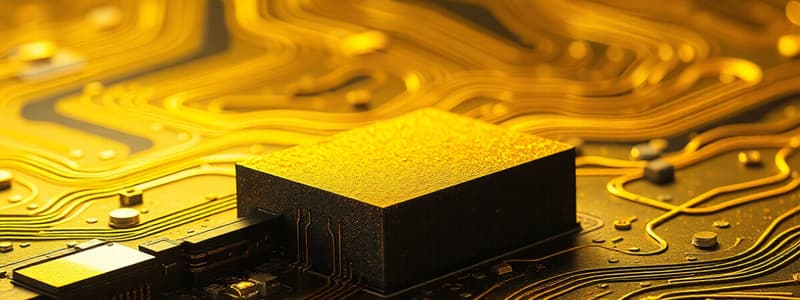Podcast
Questions and Answers
What is the primary purpose of etching in VLSI fabrication?
What is the primary purpose of etching in VLSI fabrication?
- To apply photoresist on wafer
- To cut silicon wafers from ingots
- To remove specific layers of material (correct)
- To coat surfaces with metals
What is the primary function of the electric field in plasma etching?
What is the primary function of the electric field in plasma etching?
- To create a plasma from the gas (correct)
- To cool the gas before etching
- To increase the viscosity of the etching solution
- To prevent ionization of the gas
Which etching technique uses gas instead of liquid chemical etchants?
Which etching technique uses gas instead of liquid chemical etchants?
- Photo etching
- Dry etching (correct)
- Laser etching
- Wet etching
Which chamber design in plasma etching utilizes a coil wrapped around it?
Which chamber design in plasma etching utilizes a coil wrapped around it?
What characterizes a highly selective etch?
What characterizes a highly selective etch?
Which of the following components are typically involved in plasma etching?
Which of the following components are typically involved in plasma etching?
What effect does a perfectly anisotropic etch have on sidewalls?
What effect does a perfectly anisotropic etch have on sidewalls?
In which plasma etching technique do wafers receive gas from below?
In which plasma etching technique do wafers receive gas from below?
What is an example of a reason for using wet etching in wafer production?
What is an example of a reason for using wet etching in wafer production?
What does undercutting in etching refer to?
What does undercutting in etching refer to?
What is Inductively Coupled Plasma Reactive Ion Etching (ICP-RIE) primarily known for?
What is Inductively Coupled Plasma Reactive Ion Etching (ICP-RIE) primarily known for?
Which etching technique is characterized as having a 'deep' etching capability?
Which etching technique is characterized as having a 'deep' etching capability?
What is a common result of poor selectivity in etching?
What is a common result of poor selectivity in etching?
What is one of the main advantages of dry etching over wet etching?
What is one of the main advantages of dry etching over wet etching?
What is a distinguishing feature of the Parallel Plate Reactor compared to the Barrel Type?
What is a distinguishing feature of the Parallel Plate Reactor compared to the Barrel Type?
Which plasma etching technique specifically focuses on atomically thin layers?
Which plasma etching technique specifically focuses on atomically thin layers?
Flashcards are hidden until you start studying
Study Notes
Etching Techniques
- Etching is used to remove unprotected parts of a material, primarily in semiconductor fabrication.
- Wet Etching uses strong acids or etchants to remove specific layers.
- Dry Etching uses gases instead of chemicals.
Applications of Etching
- Remove damaged regions after ingot slicing in wafer production.
- Remove unnecessary photoresist in photolithography.
- Remove unnecessary metal in metallization.
Etch Profile Considerations
- Selectivity refers to the etching process's ability to remove the target material without attacking the layer beneath.
- Isotropy describes the etch profile's shape:
- Isotropic etching produces rounded sidewalls.
- Anisotropic etching produces vertical sidewalls.
- Undercut Etching is an isotropic etch that removes more material beneath the mask than above it, creating a trench with wider bottom than top.
- Over Etching removes some of the mask material, leading to unwanted etching beyond the intended area.
Wet Etching Techniques
- Wet etching involves immersing the wafer in a liquid etchant.
- Advantages:
- Cost-effective.
- Disadvantages:
- Poor control over etch profile and uniformity.
- Can damage underlying layers.
Dry Etching Techniques
- Dry etching uses ionized gases in a plasma chamber to remove material.
- Plasma Etching utilizes a plasma to create reactive ions and radicals that chemically etch the material.
- Reactive Ion Etching (RIE) utilizes a voltage difference between the electrodes to accelerate ions towards the wafer, improving anisotropic etching.
- Inductively Coupled Plasma (ICP) Etching increases plasma density, leading to faster and more controlled etching.
Dry Etching Techniques: Types of Plasma Chambers
- Barrel Type: Wafers are placed vertically with gas flowing through the chamber.
- Parallel Plate Reactor: Wafers are placed horizontally with gas flowing from below.
Dry Etching: Advantages and Disadvantages
- Advantages:
- Higher etch profile control, enabling more precise pattern definition.
- Better control over the etching process, leading to more uniform etch depths and shapes.
- Disadvantages:
- More expensive and complex than wet etching.
- Requires specialized equipment and trained personnel.
Deeper Dry Etching Techniques
- Deep Reactive Ion Etching (DRIE): Creates deep and narrow trenches.
- Ion Beam Etching (IBE): Focused ion beam bombards the wafer, causing sputtering of material.
- Reactive Ion Beam Etching (RIBE): Combines IBE with plasma etching.
- Chemically Assisted Ion Beam Etching (CAIBE): Combines IBE with chemical etching.
- Atomic Layer Etching (ALE): Controls etching at an atomic level, creating highly precise and uniform etching.
Studying That Suits You
Use AI to generate personalized quizzes and flashcards to suit your learning preferences.




